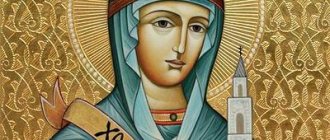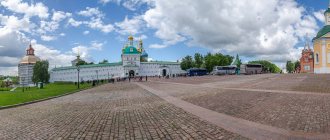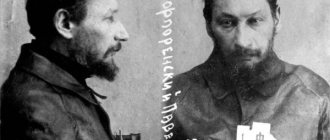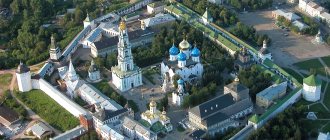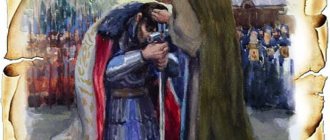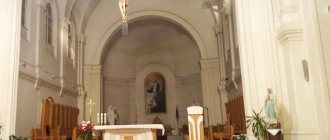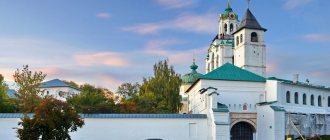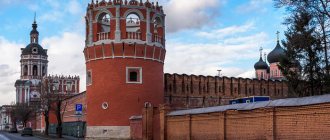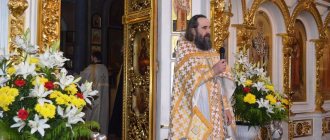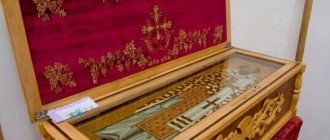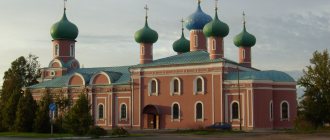The Trinity-Sergius Lavra was founded by one of the most revered saints in Rus' - Sergius of Radonezh. The history of the monastery is connected with many important events of the Russian state: the Battle of Kulikovo, the difficult period of the Mongol-Tatar yoke, the fight against foreign invaders and the first years of the reign of Peter the Great - all these pages of history did not pass by the monastery.
Russian rulers honored the Trinity-Sergius Lavra, came here on pilgrimages and provided assistance to the monastery. Tsar Boris Godunov and members of his family are buried near the walls of the Assumption Cathedral - Tsarina Maria, Tsarevich Theodore and Tsarevna Ksenia, and Olga as a monk.
The Trinity-Sergius Lavra is a working monastery located near Moscow; you can visit it on a day trip or during a tour of the Golden Ring.
Base
Sergei of Radonezh was the son of the pious Rostov boyars Cyril and Maria. As a child, his parents did not bless him for monastic life. Only when, shortly before his death, they went to a monastery, Sergei of Radonezh decided to devote his life to serving God.
But he did not go to one of the existing monasteries, but together with his older brother Stefan settled in a deep forest.
For reference: Sergei of Radonezh (in the world Bartholomew) was born in 1313, he was the middle son in the family. His teenage years were spent in study, work and prayer in the city of Radonezh, where his parents settled.
Bartholomew was a deeply religious, kind, honest and modest person; he became the support of his elderly parents, not leaving them until his last days.
The founding date of the Trinity-Sergius Lavra is considered to be 1337, when 23-year-old Bartholomew, together with his brother, built a hut and a small church dedicated to the Holy Trinity on a small hill in the forest, away from the noise of roads and villages.
This is how the history of the Trinity-Sergius Lavra began.
Brother Stefan could not stand the difficult conditions of a solitary life and went to the Moscow Epiphany Monastery. Sergei of Radonezh lived alone for several years, but soon other monks began to gather around him, each of whom built himself a hut and cultivated his own garden.
How to get there
It is very easy to get to the monastery from Moscow. It is enough to take the train, which departs from the Yaroslavl station. You need to take those going to Balakirevo or Alexandrov. With the help of railway transport you can cover the journey in an hour and a half.
Bus number three hundred and eighty-eight departs from the VDNKh metro station. If you don't get caught in a traffic jam, the journey will take only an hour. The fastest way to get to the monastery is with your own car. Sergiev Posad is located on the forty-sixth kilometer of the Yaroslavl highway.
Author of the publication
offline 3 years
Nika
18
I am interested in hiking and traveling, photography and videography. I have been going hiking since childhood. The whole family went and went - sometimes to the sea, then to the river, to the lake, to the forest. There was a time when we spent a whole month in the forest. We lived in tents and cooked over fires. This is probably why I am still drawn to the forest and, in general, to nature. I travel regularly. About three trips a year for 10-15 days and many 2 and 3 day hikes.
Comments: 0Publications: 668Registration: 10/23/2018
Nika Attractions
Formation of the monastery
When the number of monks increased to 12, all buildings were surrounded by a fence for safety from animals. There were no leaders in the monastery and, thanks to respect, Sergius of Radonezh played the role of leader. Soon, by order of the Moscow church authorities, he was ordained a priest and appointed abbot.
A charter began to operate in the monastery, in accordance with which the monks formed a single community and began to run a joint household.
In this regard, the structure of the monastery also changed: a refectory and utility rooms were built. The church was located in the center of the monastery, and on four sides of it there were cells. A gate church was built above the main gate in the name of the Holy Great Martyr Demetrius of Thessalonica.
At that time the monastery was poor, there was not enough bread and salt, butter and flour.
In the first decade of its existence, the monastery became widely known, and Sergius of Radonezh was highly respected by Prince Dmitry Donskoy. Metropolitan Alexy of the Russian Orthodox Church wanted the Trinity Abbot to become his successor, but Sergius of Radonezh refused such an honor.
Monastery during the Mongol-Tatar yoke
The time when St. Sergius of Radonezh lived (1314–1392) was very difficult for Rus': constant raids by the Mongol-Tatars forced people to think only about how to survive.
St. Sergius considered it his duty to take care of their spiritual education. On the eve of the Battle of Kulikovo, he blessed Dmitry Donskoy to fight the horde of Mamai. Inspired by the instructions of the abbot, the soldiers of Dmitry Donskoy defeated the army of Mamai.
Also, the Trinity abbot tried to try on the princes who were at war with each other.
The monastery became a real center of culture and education.
However, at that time the monastery was not well fortified; there was only a wooden fence to protect it. Therefore, during the attack on the Russian lands of Khan Toktamysh, the monks were forced to take refuge in a safe place - on the territory of the Tver Principality. This time the monastery survived, but in 1408, during the speech of Khan Edigei, it was destroyed. Thanks to the efforts of Hegumen Nikon, the successor of Sergius of Radonezh, the monastery was rebuilt.
Refectory Church
Church of St. Sergius with the Refectory Chamber (1686–1692).
These are not all the temples and cathedrals of the Trinity-Sergius Lavra. Each of the buildings has its own history, characteristics and spiritual and cultural value. And all together they form an amazing place, the center of history, spirituality, artistic rarities and the center of spiritual Orthodox culture in Rus'.
In addition to churches and temples, on the territory of the Lavra there is a source of spring water, where anyone can quench their thirst.
It seems important to say a few words about the founder of this center, hieromonk of the Russian Church Sergius of Radonezh (1314-1392). His name personifies the beginning of Russian spirituality. Despite the fact that he did not leave written evidence, he preserved his memory in his spiritual mentoring, as well as in his practical work pleasing to God - the creation of monasteries. In the spiritual sphere, he is considered the patron saint of students. In the 15th century he was ranked among the Order of Saints by the Orthodox Church. In 1969, by order of Pope Paul VI, his name was included in the calendar of services of the Roman Catholic clergy.
Construction of stone churches in the 15th century
In 1422, the year of the official canonization of St. Sergius, the Trinity-Sergius Lavra was decorated with new stone buildings.
Trinity Cathedral
On the site of the old wooden church, the white-stone Trinity Cathedral was erected by the Monk Nikon “in honor and praise” of the founder of the monastery. Among those who contributed funds for the construction was the son of Dmitry Donskoy, Prince of Zvenigorod and Galitsky Yuri Dmitrievich.
Trinity Cathedral is the oldest white-stone church of the monastery, built in 1422–1425. There is often a queue to see the beautiful silver shrine where the relics of St. Sergius of Radonezh rest.
The interior of the cathedral was decorated with paintings made by painters Andrei Rublev and Daniil Cherny. Unfortunately, the frescoes have not survived to this day, but icons by Andrei Rublev can be seen in the unique five-tiered iconostasis.
It was for this iconostasis that the famous icon of Andrei Rublev “The Holy Trinity” was created, which was in the temple before the October Revolution, and then was transferred to the State Tretyakov Gallery, where it is currently located.
Next to the shrine there is an inconspicuous double-leaf forged iron door; this is the entrance to the chapel of the cathedral, the Serapion Chamber, in which Orthodox shrines are kept, there are more than five hundred of them. There is a 5–7 cm hole preserved on the door; this is a trace from a Polish cannonball that flew into the temple during the siege of the monastery and, fortunately, did not explode. The chamber is named after Serapion, the former archimandrite of the Trinity Monastery, who was buried here.
In 1476, Pskov craftsmen erected a brick church-belfry in the name of the Descent of the Holy Spirit on the Apostles.
The fortress walls, towers and the Dmitrievskaya Gate Church were still wooden.
Monasteries of Sergiev Posad
When choosing what to see in Sergiev Posad, social travelers often give preference to beautiful buildings or monuments, taking wonderful selfies against such an impressive backdrop. Orthodox tourists, on the contrary, first of all strive to visit places of spiritual power, which will be discussed below.
Pokrovskaya monastery
- Opening hours: daily, from 6:00 to 21:00.
- Telephone.
- Website: https://khotkovmonastery.ru
- Address: Khotkovo city, st. Kooperativnaya, 2. Electric train stop “Khotkovo Station”.
The Pokrovskaya or Khotkovskaya convent, built in a picturesque place on the banks of the Pazha River, is one of the oldest monasteries in Rus'. In any case, the first chronicle mention of it dates back to 1308. The main components of the marvelous architectural ensemble that tourists admire today appeared here almost 500 years later. Thus, the construction of the classic five-domed Intercession Cathedral was completed in 1816, and the Byzantine St. Nicholas Church in 1904. The Nativity of the Baptist Church above the Holy Gates is considered the oldest building. The river of pilgrims trying to get to the monastery does not dry out. Believers come here to venerate the relics of St. Mary and Cyril, the parents of St. Sergius of Radonezh.
Chernigov monastery
- Opening hours: daily, from 6:30 to 19:00.
- Telephone.
- Website: https://skit-chernigovsky.ru
- Address: st. Gethsemane ponds, 1. Transport stop "Kalyaevskaya".
Just three km from Sergiev Posad there is another monastery that simply cannot be missed. This is the Chernigov monastery, founded in 1844 over the underground cell of the Moscow holy fool Filippushka. The monastery received its name from the miraculous icon of the Mother of God of Chernigov, presented as a gift to the cave temple. The main structures of the monastery, surrounded by a brick wall with corner towers, were erected in the late 19th – early 20th centuries. The dominant feature of the monastery complex is the architectural ensemble consisting of a five-tier bell tower and the building of the Chernigov Cathedral.
Construction of defensive structures
In the 14th–17th centuries, Rus' experienced severe pressure in the east from the Golden Horde and in the west from the Principality of Lithuania. Only a single state could resist these forces. A unified defensive system began to be created on the scale of the entire Russian state.
The Trinity Lavra of St. Sergius, located on the outskirts of Moscow, became an important fortress designed to protect the capital.
The history of the new defensive structures of the monastery began in the 1540–1550s. Then a stone wall about 1.5 kilometers long was built in the shape of an irregular quadrangle with 12 towers (11 have survived to date). The natural barrier for the enemy was the ravines, and additional obstacles were the dug ditch and pond.
In the middle of the 17th century, the fortifications were strengthened, improved and acquired a modern look.
The walls of the fortress have three battle tiers, and most of the towers have six tiers. The most interesting of them are the Pyatnitskaya and Krasnaya, Utochya and Beer towers.
- The beer tower had a spare, or secret, exit from the fortress, through which sorties took place during the siege of the fortress at the beginning of the 17th century
- The Corner Duck Tower was named so because, according to legend, Tsar Peter the Great used it to shoot ducks swimming in a pond next to the fortress wall.
- The Pyatnitskaya Tower previously had a tower for monitoring the surrounding area. During the siege of the fortress, the tower was destroyed and rebuilt in 1640
- The Red Tower is where the main gate to the fortress is located. Behind it there was previously a gate church built in 1513 in honor of St. Sergius of Radonezh. Later it was rebuilt into a church, topped with five domes in honor of the Nativity of St. John the Baptist.
Beginning of a walking tour of the monastery territory
The Trinity Lavra of Sergius receives its many visitors through the main entrance from the west, from the Moscow road. The passage is organized into the arch of the Red Tower, not in the sense of color, but because of beauty and solemnity. The tower itself is completely white, like the fortress walls into which it is built. The entrance was equipped with a figured portal at the beginning of the 19th century; it is distinguished by its color and rich decoration. The entrance arch is framed with colorful stucco molding, and there are pilasters with capitals on the sides. The pediment is equally colorful, with an icon of the Holy Trinity on it.
The upper part of the Red Tower is decorated with an arcade; there are images of the Savior, Our Lady and Sergius of Radonezh. The configuration of the combat embrasures, with a downward sloping plane for firing at advancing enemies, attracts attention. The loopholes were tested during the Time of Troubles; memorial plaques remind of the 300th anniversary of those events. They were installed by the Imperial Military Historical Society, were removed under the Bolsheviks, and have now been restored. One can argue about their appropriateness at a religious site, but this is a historical memory.
Painted life of Sergius of Radonezh
The arched corridor in the Red Tower is painted with works of modern icon painters, copying the style of old masters. Episodes from the biography of the founder of the monastery, or according to the church, the life of St. Sergius of Radonezh, are presented. Not only the Trinity Lavra of Sergius owes him, all Russian people, he inspired their ancestors to fight the Horde. The paintings depict the saint’s real affairs and life situations, but the surroundings are clearly fictitious. However, this does not look absurd, just a flight of imagination, a touch of fabulousness.
St. Sergius is presented in settings that never accompanied his life, shown against the backdrop of majestic buildings. Many wonderful birds are an allegory of the disciples of the preacher and mentor, called to continue his work. The picture can be called visionary in meaning, but it was written based on already known facts. The adjacent scene of the blessing of Prince Dmitry, the future Donskoy, is no less expressive and full of symbolism. According to chronicle memoirs, the saint accompanied the soldiers to battle with assurances of God’s support.
A look at the gate church
Seen from above, the gateway Church of the Nativity of John the Baptist looks neat and fresh, although it was built in 1699. The Trinity Lavra of St. Sergius was financed by the then successful industrialist and generous philanthropist Grigory Stroganov. Having inherited many lands and serfs, he became rich, not in the most righteous way, from salt mining. To atone for sinful actions, he donated a lot to monasteries and built several churches. They even singled out an architectural direction - Stroganov baroque, which combined folk features, five-domed churches with baroque pomp.
Turning around and looking at the temple from below, it is impossible to fully grasp its appearance. However, what is visible also allows one to get the impression that the device and especially the coloring are unusual. Very contrasting, purely geometric ornaments are not at all characteristic of folk architecture; they are something foreign. The columns entwined with vines are quite nice, the capitals are well made, and the arches made of shells look interesting. The sectorial gilded domes, much wider than the light drums, resemble oversized hats.
Trinity Sergius Lavra immediately after entering the territory
From the arch of the gate church, visitors find themselves at a fork between three temples, at short distances. The Church of St. Sergius of Radonezh is poorly visible behind the trees; you will still come across it when going around. In the center there is a triangular lawn with burial crosses and the apse of the Church of the Descent of the Holy Spirit, which we will also see from a better angle. From here it is clearly seen that the only chapter in this church plays the role of a bell tower, which is quite rare in religious architecture. The coloring of the dome is unusual, as if divided in two by a golden stripe.
In a straight line in the distance is the building of the Treasury building, the building of the financial department, the Trinity Lavra of Sergius had it for economic activities. From here you can also appreciate the decorative decoration that adorns the Trinity Lavra of St. Sergius. The tree plantations are not impressive in size, but the thickness of the trunks shows serious age. By skillful pruning, compact crowns are formed, which are somewhat small for trunks of such diameters. The flower growers of the monastery do their work diligently, the flower beds are neat and well-groomed.
Creation of the Assumption Cathedral and other churches
Assumption Cathedral
In 1559–1585, a new five-domed cathedral was erected in the center of the monastery, in the east of Cathedral Square. Ivan the Terrible and his family were present at its laying. The temple was built similar to the Assumption Cathedral of the Moscow Kremlin, but was inferior in size. At the same time, the built cathedral was larger than other monastery churches.
Like the cathedrals of Vladimir and Moscow, it was named Assumption. In 1684, the walls, vault and pillars of the temple were decorated with frescoes on biblical themes. In the northwestern part of the cathedral there is the tomb of the family of Tsar Boris Godunov, over which in 1780 a tent tent was erected, which has not survived to this day.
The temple took a long time to build - about 25 years, there was not enough funds and, basically, it was built with royal donations. Ivan the Terrible gave generous contributions for the memorial of the soul of his murdered son. But the consecration of the Assumption Cathedral took place in 1585, after the death of Ivan IV, under his third son, Tsar Feodor Ivanovich.
- Opposite the Assumption Cathedral, on the western side of Cathedral Square, is the Treasury building of fraternal cells. Adjacent to it: from the north - Hospital wards with the tented church of St. Zosima and Savvaty of Solovetsky, erected in 1635–1638
- from the south there is a three-story Staircase Tower.
LiveInternetLiveInternet
The Holy Trinity-Sergius Lavra in the world is called more simply - the Trinity-Sergius Lavra, and under this name it is known throughout the world. This is the largest Orthodox monastery in Russia - stauropegial, independent of the local clergy.The city in which this monastery is located is called Sergiev Possad - it appeared thanks to St. Sergius of Radonezh, the greatest ascetic of the Russian land. Perhaps there has not been a greater person in the Russian Orthodox Church in its entire history, but St. Sergius belonged and belongs not only to the church - he was called the abbot of all Rus', and he had a tremendous influence on the fate of the country and its entire history.
The future ascetic was born in 1319, into a pious boyar family, and always wanted to serve God, but his parents believed that he should not withdraw from the world, and did not give their son their blessing. At the end of their lives, however, they decided to go to a monastery, and then the future Sergius (in the world Bartholomew) together with his brother Stephen were also able to leave the world. They chose a desert on a wooded hill, away from people, built a cell and a wooden church there with their own hands, and dedicated it to the Life-Giving Trinity. Bartholomew was only 23 years old, and he could not even imagine what this place would become for the entire Russian land - he most of all wanted solitude.
The elder brother was unable to withstand the hermit's life and moved to one of the monasteries, while the younger brother remained, not intending to give up his decision. Then what he wanted most of all came true - the abbot of a nearby monastery tonsured him as a monk, under the name Sergius.
Being in solitude, St. Sergius worked every minute physically and spiritually: he worked on the land, prayed, sang psalms and read sacred books, and every day he gained greater spiritual strength. All he wanted was to unite with God and save his own soul, but God apparently judged otherwise.
Since the monk did not desire fame and honor, but spent his days quietly in fasting and prayer, he learned humility - and this is one of the most important Christian virtues. A humble and pious person can not only save himself, but also save many other people, and they learned about Sergius not only in the nearest villages and cities, but also in the far corners of Rus'. His extraordinary spiritual power attracted many people to him, and they began to settle nearby, begging him to help - to guide them, so that they too could save their souls.
Sergius had disciples, and at their insistence he became a priest and abbot at the Trinity Monastery, founded by him in the 1340s. After some time, the monastery became a communal monastery: funds were even donated for its improvement, although Sergius never strived for improvement. The territory was divided into parts: in addition to residential, there was also public and defensive; Inside the courtyard there was a church and a refectory, which was surrounded by cells on four sides.
Imperceptibly, this monastery turned into the spiritual center of all Russian lands, and the Moscow princes looked to it for help and support. The Monk Sergius had such high authority that he was a state adviser to all the Moscow and other princes; he also resolved internecine disputes if they arose.
The most famous historical act is considered to be the participation of Sergius of Radonezh in the preparation of the Russian army for one of the greatest battles - the Battle of Kulikovo Field. Demetrius Donskoy came to the Trinity Monastery on the eve of the battle, and received a blessing from the monk - both he and his entire army.
Sergius sent two monks with the prince - real Russian heroes Peresvet and Oslyabya. Everyone knows from textbooks how the battle began: Peresvet went out to duel with the Tatar warrior Chelubey, and they struck each other with spears; then the regiments entered the battle. The battle raged until the evening, and the Tatars fought fiercely - it was very difficult for the Russians, but they held on, and by the evening Mamai’s army was completely defeated. The remaining Tatars were driven for a long time - all the way to their camp, and rich trophies were captured there. After the battle, Russian soldiers buried the dead for 8 days - their own and the Tatars, and since then the Kulikovo Field has forever become holy for Rus'.
Prince Dimitri performed a commemoration at the Trinity Monastery for all Russian soldiers who fell in battle on this great day in history.
Sergius of Radonezh died in 1392, at the age of 78, and the monastery continued to develop and prosper - it became not just a religious, but a real spiritual and cultural center of the state. It was there that the most famous icons were painted and chronicles were compiled, and in the 15th century, one of the greatest monuments of Russian literature, “The Life of St. Sergius of Radonezh,” was created in the Trinity Monastery.
After the Battle of Kulikovo, the monastery endured many hardships: in 1382, the hordes of Tokhtamysh came to Rus', but did not find the monastery in the forests, but in 1408 they finally reached it. The monastery burned down completely, but was very quickly rebuilt and revived - so there were no major losses.
Construction of the Trinity Cathedral began in 1422, over the tomb of St. Sergius. This cathedral belongs to the early Moscow architectural style: it is austere, modest and not very large - not like the Assumption Cathedral, built by Ivan the Terrible in the 16th century.
The monastery, founded by Sergius of Radonezh, was respected and revered by all Russian tsars, and Ivan the Terrible was baptized there. Under him, a white stone wall appeared there, and he donated his own funds for the construction of the new cathedral: the formidable king, for all his cruelty, was distinguished by his fear of God. The cathedral took a long time to build - about 26 years, and in size it surpasses the other monastery churches, however, thanks to its amazing beauty, it does not overwhelm them with its grandeur. The Assumption Cathedral is truly stunningly beautiful: its bright blue and gold domes stand out among other monastery buildings, and from afar it attracts the eye - one might say that it is the calling card of the Trinity-Sergius Lavra.
The Trinity Monastery also played its role in the Time of Troubles: the Polish-Lithuanian invaders besieged it for 16 months, but achieved nothing; Minin and Pozharsky gathered their Second Militia here; Donations were collected in the monastery for the Russian army.
Princess Sophia, as well as princes Peter and Ivan, hid in the monastery from the Streltsy riot in 1682, and later young Peter took refuge in it, having fled from Moscow during the next unrest. The Church of St. Sergius of Radonezh and a very beautiful refectory were built here precisely under Peter I.
Elizaveta Petrovna ordered to assign the status of a monastery to the Trinity Monastery in 1742, but the decree of the Holy Synod on this came out only 2 years later: the Trinity-Sergius Monastery began to be called a lavra.
It is impossible to write briefly about this greatest of Russian monasteries. In Russia, he was one of the richest - he owned vast lands and more than 100 thousand peasants. The monastery traded salt, grain and other goods, and in the 17th-18th centuries it was not only financially independent, but also donated large amounts of money to the Russian army. For example, in 1812, about 70,000 rubles were donated - a lot of money at that time.
By the end of the 19th century, the Lavra had its own printing house; she owned shops, hotels, horse yards and workshops. The workshops made crosses and candlesticks, toys and even carved furniture - this also brought in income. At the beginning of the 20th century, about 400 monks lived in the monastery, and other monasteries were assigned to it.
In addition to the relics of St. Sergius, there are many other shrines and burial places in the Lavra. Not only clergy are buried here, but also representatives of the most ancient families of the Russian aristocracy, people of royal origin - for example, from the Godunov family. The famous “Trinity” by Andrei Rublev was kept in the Trinity-Sergius Lavra for hundreds of years (today it is in the Tretyakov Gallery); in the sacristy of the monastery real treasures are collected - offerings from kings, Russian nobles and simply rich people; The library stores chronicles, handwritten and early printed books, and unique historical documents.
In 1920, the Lavra was closed - it was turned into a museum, but in 1946 the activity of the monastery was resumed. Today, the Trinity-Sergius Lavra is again the spiritual and religious center of Russia, and at the same time remains a unique museum - its architectural ensemble is included in the UNESCO World Heritage List and is under its protection.
Author Gataulina Galina
Time of Troubles
At the beginning of the 17th century, False Dmitry II sent his loyal governors Peter Sapega and Alexander Lisovsky with Polish and Lithuanian invaders against Russian cities. Pereyaslavl-Zalessky and Rostov the Great, Yaroslavl and Suzdal, Vladimir and Nizhny Novgorod were devastated. A testing period began in the history of the Trinity-Sergius Lavra.
In September 1608, Polish-Lithuanian troops approached the monastery. The fortress held a siege for 16 months. By the end of 1609, due to harsh conditions and lack of food, more than 2,000 defenders of the fortress died of scurvy. The survivors steadfastly defended the fortress and on January 12, 1610, the siege was lifted with the help of arriving Russian troops led by Mikhail Skopin-Shuisky.
After the siege was lifted, the destroyed fortress walls were restored and a permanent garrison of archers and gunners was stationed on the territory of the monastery.
In 1618, the Polish prince Vladislav, using the support of the Polish Sejm, tried to take the Moscow throne. Having organized a campaign against Moscow, he approached the Trinity-Sergius Monastery and tried to take it. But the fortress survived this time too.
After these events, the authority of the monastery increased, and donations for its construction increased. Defensive structures were improved and new temples were built, and old buildings were also decorated.
The reign of Peter the Great
At the end of the 17th - beginning of the 18th century, during the time of Peter the Great, the Trinity-Sergius Lavra again came to the fore in connection with the political events of that era.
In 1682, during the Streletsky riot, Princess Sophia and princes Ivan and Peter took refuge behind the walls of the fortress. And seven years later, in 1689, Peter hid here, having fled from Moscow. It was in the Trinity-Sergius Lavra that the massacre of Sophia’s supporters took place and from here Peter left for Moscow as an autocratic ruler.
At the beginning of the 18th century, the construction of stone buildings was prohibited and the construction of monastic buildings was suspended. Soon Russia enters the Northern War and for military needs Peter the Great takes 400 thousand rubles from the monastery treasury.
In connection with the threat of the Swedish king's campaign against Russia, the fortress was strengthened: additional bastions were built on the corner towers, since modern guns for that time could not be placed on the previously built walls and towers.
Brief history of Sergius Lavra
The monastery was founded in the mid-14th century by Saint Sergius of Radonezh
. The authority of this man was truly enormous. He had a very serious influence on the spiritual life of Russia both in his century and in subsequent times. As the followers of St. Sergius developed and disseminated his teachings, the monastery enjoyed increasing influence. Up until the 18th century inclusive, it was constantly growing and being built up. Almost all buildings dating back several centuries have survived to this day.
Tsars and boyars often left their luxurious palaces and made a pilgrimage on foot to the Trinity Monastery. Among them was the “terrible and great” Ivan the Terrible
and
Peter the Great
and many others
.
The most famous watchtower is called the “duck tower”.
When Peter the Great
was secretly in the monastery during the struggle for power with his sister Sophia, he shot ducks from here.
In 1920
the monastery was closed. The monks were forced to hide, many of them were killed. Some found refuge in the Chernigov monastery, located nearby (the Lavra then owned numerous wastelands and small monasteries located nearby). After World War II, religious life in the Trinity-Sergius Lavra resumed.
Detailed history of the Holy Trinity Sergius Lavra
Soviet time
In May 1920, the last service took place and soon a historical and archaeological museum was organized in the premises of the Trinity-Sergius Lavra. All the brethren were evicted and began to live in labor communes. Nine years later, most of the monastery bells were removed and melted down; only the “Swan” bell of 1593 and the “Nikonovsky” bell of 1420 survived.
Monastic life returned to the monastery in the post-war years. The first liturgy took place on the night of Easter, April 21, 1946.
Until 1983, the monastery was the residence of the Russian patriarchs; later it was moved to the Moscow Danilov Monastery.
The Trinity-Sergius Lavra is one of the most revered monasteries among the Russian people. Thousands of believers and pilgrims rush to venerate its shrines, and numerous tourists admire the historical and architectural monuments created by the best craftsmen of the 15th–19th centuries. Since 1993, the monastery buildings have been under the protection of UNESCO.
Where to go with children in Sergiev Posad
This amazing city is a must-see for your child. A visit to some interesting places in Sergiev Posad will be remembered by the young traveler for a long time.
Toy Museum
- Opening hours: from Wednesday to Sunday inclusive, from 10:00 to 17:00.
- Ticket price: adult 250 rubles, reduced price 120 rubles, children under 4 years old are admitted free.
- Telephone.
- Website: https://museumot.info
- Address: Red Army Avenue, 123. Transport stop "Park Kultury".
In Sergiev Posad there is the oldest and largest toy museum in Russia. The institution’s collection, which the famous metropolitan artist M. Bartram began to form back in 1918, is amazing. It contains more than 160 thousand toys created by Russian, Soviet, and foreign masters. The exhibition halls display exhibits made of wood, metal, ceramics, and fabric. Some of the rarities that brought joy to the great-grandparents of today’s visitors are over 100 years old. Until 1931, the museum operated in Moscow , and then moved to Sergiev Posad. Today, its exhibitions are displayed in the halls of a historical mansion, very similar to a small medieval castle.
Ethnopark "Nomad"
- Opening hours: on weekends, from 10:00 to 18:00.
- Ticket price: adult 500 rubles, student 350 rubles, children under 17 are admitted free.
- Telephone.
- Website: https://ethno-park.ru
- Address: 61st kilometer of Yaroslavl highway. Stop of the Khotkovo train.
Not far from Sergiev Posad is the town of Khotkovo, in the vicinity of which there is a wonderful place where you should definitely bring your child. The ethnographic park, “inhabited” by various nomadic peoples, is located on a vast field. Recreation is divided into several camps. The reconstructions accurately reproduce the surroundings of the settlements of the Mongols, Altaians, Bashkirs, Kazakhs, Buryats, Kyrgyz, and Tuvans. A separate part of the exhibition tells about the culture and life of the nomads of the Far North. Visitors to the ethnopark will learn how to use a lasso and shoot with a bow. Children love to watch the colorful inhabitants of the camps - camels, yaks, sled dogs, sheep, goats.
